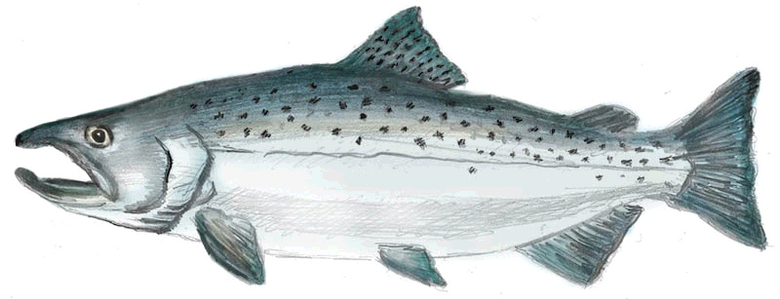Nearly a decade after the last Elwha River dam came down, the Lower Elwha Klallam Tribe could see its first fishery on the river in years.
The tribe, Olympic National Park and the Washington Department of Fish and Wildlife announced Monday that the tribal ceremonial and subsistence fishery for coho salmon on the Elwha will open this fall.
The Elwha will remain closed to commercial and recreational fishing. Mountain lakes in the Elwha basin within Olympic National Park and Lake Sutherland will remain open to sport fishing from the fourth Saturday in April through the end of October.
For more than a century, the Elwha and Glines Canyon dams blocked salmon and oceangoing trout from more than over 90% of the Elwha watershed. They held up sediment and woody debris that would otherwise make its way down to nourish the downstream habitat.
It took an act of Congress in 1992 to free the Elwha. The $325 million Elwha experiment remains the biggest completed dam removal project ever. With 83% of the Elwha watershed permanently protected in Olympic National Park, it offered an opportunity to start over.
More than a decade ago, as the dam removal work began, the river’s tribal, state and federal managers suspended all fish harvesting to allow populations to recover.
One of the biggest concerns in dam removal was the 20 million cubic yards of sand, gravel and silt locked up behind two dams. It can clog salmon and steelhead gills and kill fish attempting to spawn in the river. The Lower Elwha Klallam Tribe used hatcheries to keep fish populations stable, and today, thousands of salmon are returning to their historical spawning habitat.
In 2019, just five years after the project was completed, endangered Chinook returns were the highest since the late 1980s: an estimated 7,600.
More than 90% of the surveyed coho returning to their spawning grounds on the Elwha in 2012 and 2013 were tagged hatchery fish. In 2021, less than 4% of the coho were tagged, suggesting wild, naturally spawned fish are finding their way back.
Last year, more than 70,000 baby coho salmon hatched and headed out of Indian Creek, a tributary of the Elwha. This fall, an estimated 3,666 hatchery and 3,456 wild adult coho are expected to make their way back up the Elwha to spawn and die.
That’s more than the hatchery needs, said Pat Crain, Olympic National Park fisheries biologist. It’s clear the small number of fish the tribe plans to harvest will in no way affect the long-term recovery of the Elwha, Crain said.
Roy Zipp, acting deputy director of Olympic National Park, remembers hearing murmurs about Elwha dam removal back in 1992 when he was working in Mount Rainier National Park.
“This project has been a really long time coming,” Zipp said Monday. “Being able to open it up to subsistence fishery fishing is awesome. … I think it demonstrates the resiliency of aquatic systems.”
Fishery co-managers expect that no more than 400 coho will be harvested as part of the tribe’s ceremonial and subsistence fishery.
It’s still early in the 20-plus-year Elwha salmonid recovery process, wrote Matt Beirne, natural resources director for the Lower Elwha Klallam Tribe, in an email.
Recovery monitoring in the Elwha is a long-term, cooperative effort among Olympic National Park, the National Oceanic and Atmospheric Administration fisheries, the U.S. Fish and Wildlife Service, the U.S. Geological Survey, and the state Department of Fish and Wildlife. The partners each year collect data on the number of spawning fish, their distribution and the number of out-migrating young fish.
This October, the tribe will harvest adult coho salmon on the lower 3 miles of the Elwha River. The timing is intended to help minimize effects on Endangered Species Act-listed Chinook and steelhead.
The fishery will include a mix of handheld gear and river nets. Nets will be limited to half the span of the river, according to the Northwest Indian Fisheries Commission. This fishery will be monitored by fisheries biologists from the tribe and enforcement officers, and the tribe and U.S. Fish and Wildlife Service will evaluate the effects of fishing gear types on the release survival of species not included in the fishery.
The decision to open a limited harvest this fall was informed by sonar and visual spawner surveys and juvenile out-migration counts. In addition, the Lower Elwha Klallam Tribe tested fishing methods on hatchery fish to see the effects on those released last year.
Opening a limited subsistence fishery will allow the co-managers to study how other fisheries might return to the Elwha, said James Losee, regional program manager for the state Department of Fish and Wildlife.
“And then the thought has been with the tribe’s amazing patience over you could say the last 100 years,” Losee said, “we would want to see how to get those treaty fisheries out there first.”
The Elwha watershed is central to Lower Elwha Klallam culture. Until settlers arrived, Indigenous fishers could rely on the Elwha to provide for their families. And the tribe for years has not been able to exercise its treaty-protected right to fish there.
“I look forward to fishing the Elwha River. I have been on the river most of my life. It will provide food for my soul and family. It will keep the fishing culture alive not only for me, but for my 16-year-old son,” Lower Elwha Klallam Vice Chairman Russ Hepfer said in a statement. “So many youths and adults have given up gill-net fishing as the economic value is not there. Many have turned to harvest of shellfish, which provides more value. I hope opening the river to fishing will revitalize our fishing culture and traditions.”
Seattle Times staff reporter Lynda Mapes contributed to this report.

The opinions expressed in reader comments are those of the author only and do not reflect the opinions of The Seattle Times.